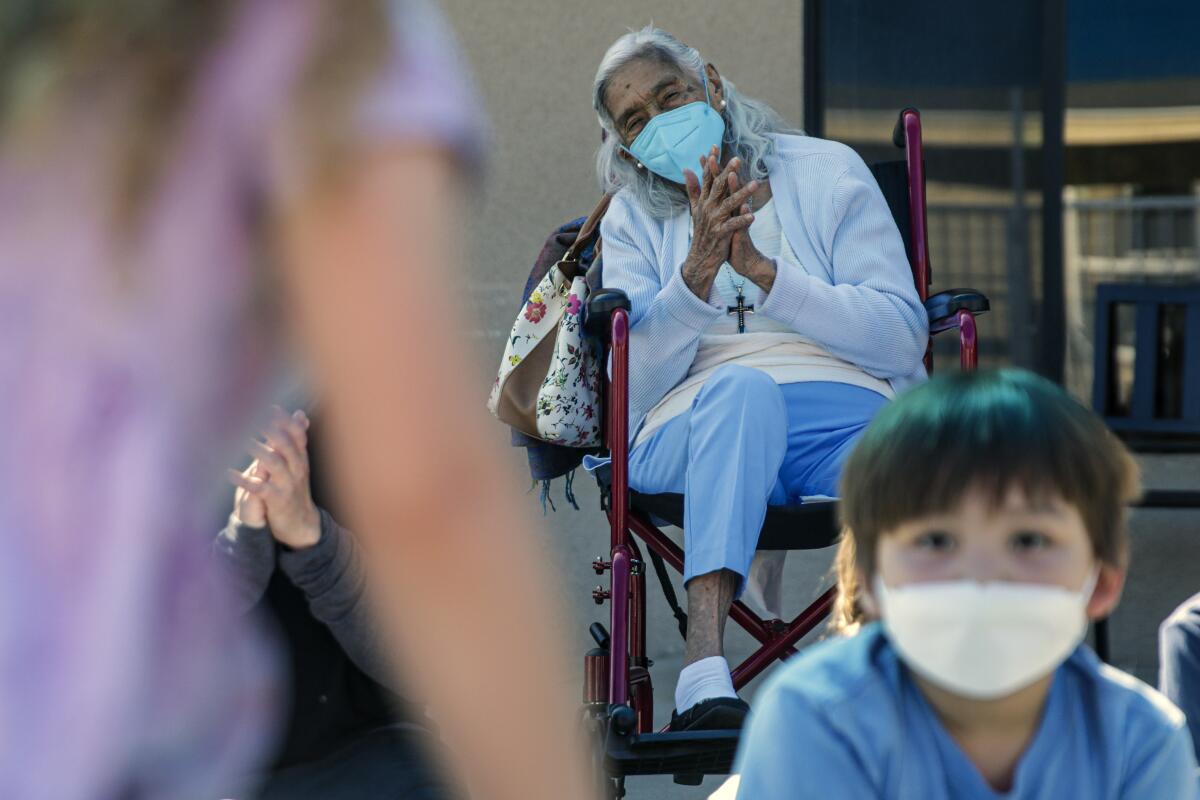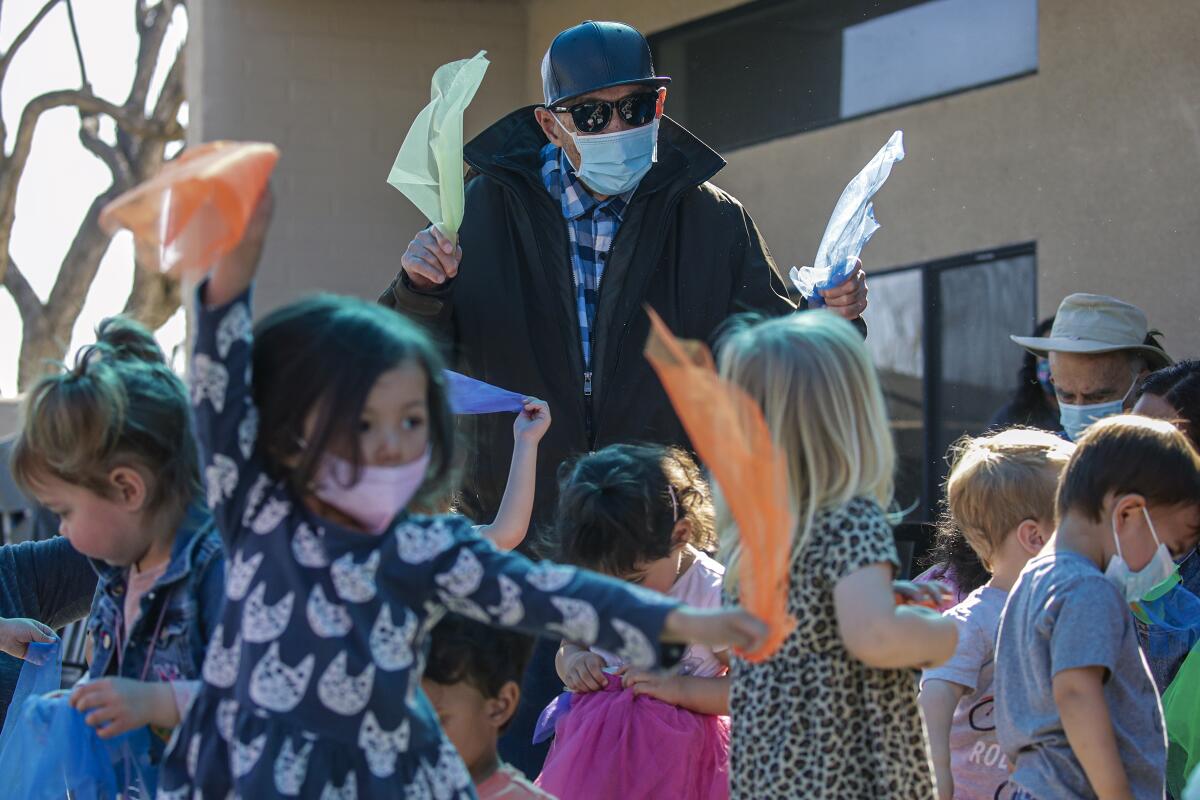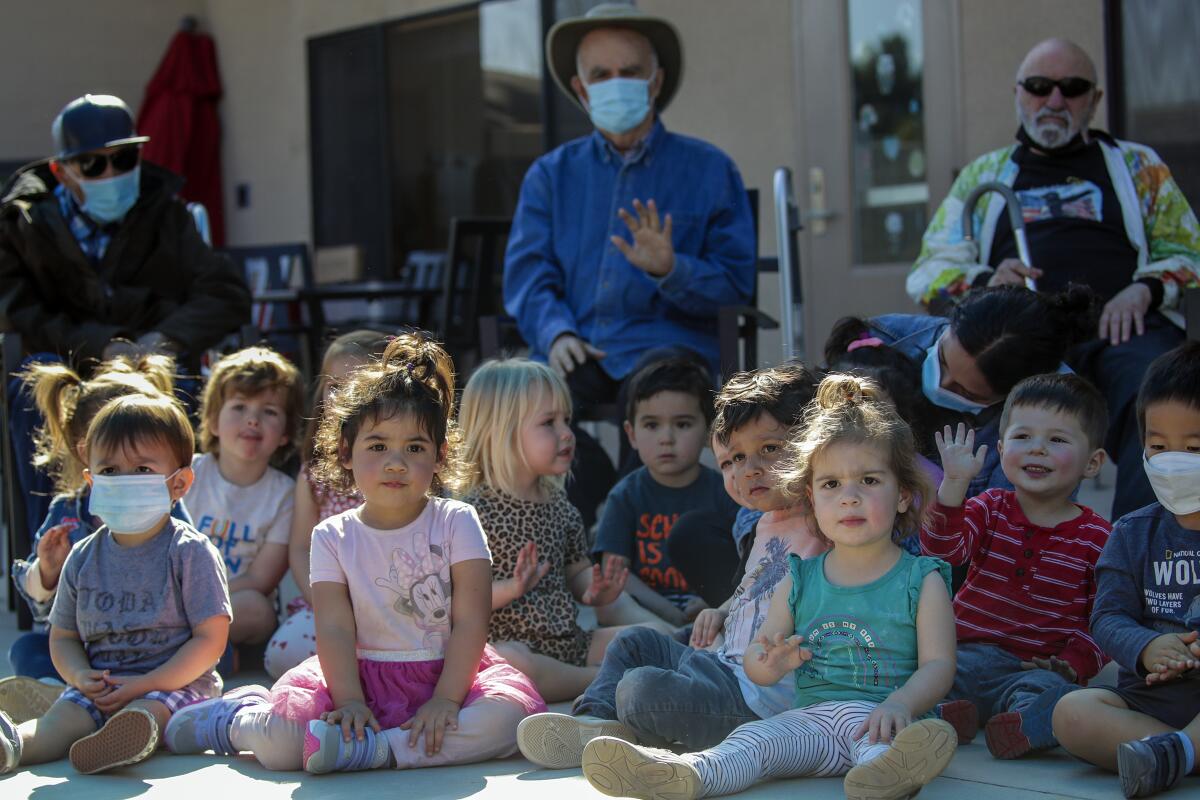Connections between young and old people are harder to come by these days. How do we fix that?

This is the March 21, 2022, edition of the 8 to 3 newsletter about school, kids and parenting. Like what you’re reading? Sign up to get it in your inbox every Monday.
When I was little, my grandma would pick me up from elementary school in her old Mercedes-Benz station wagon. She’d always be playing Elton John or Don McLean’s “American Pie,” which had a sedative effect on my energetic little sister. At Grandma’s house, we’d try on her collection of vintage hats and beg her to tell us stories from when my mom was a kid.
Those afternoons are some of my best childhood memories. My grandma offered a kind of calm, undivided attention that my mom and dad — who both worked full time — often couldn’t. I feel so lucky to have had that regular time with my grandma. Many kids grow up without grandparents in their lives because they’ve died or live far away. And in American culture, there aren’t many natural opportunities for children and older adults to cross paths in a meaningful way.
I’ve been thinking about how the pandemic, because of efforts to keep our most vulnerable community members safe, has widened the degree of separation between old and young people. What are the consequences of that gulf, of our little ones having fewer opportunities to learn from the wisest among us?
As Bill Thomas, a doctor and international authority on elder care, said in an interview with the Atlantic: “We live in a culture, time, and place where creative people have to use creative means to accomplish something that was always the most ordinary, customary thing in the human experience: older people and younger people sharing their lives.”
Since the mid-1900s, institutions have been coming up with ways to match the untapped resource of older adults with the unmet needs of our most vulnerable young people. The Americorps’ Foster Grandparents Program, for example, has since 1965 paired low-income seniors (who are paid a small monthly stipend) with students who need mentoring and tutoring.
Other programs were born out of necessity. In Jenks, Okla., pre-K and kindergarten classrooms were relocated to a skilled nursing facility because the local elementary school was overflowing. The site’s “reading buddies” program engages older adults as tutors, and ice cream socials and other informal activities encourage cross-generational mixing.
This kind of “shared-site” setup is rare, with fewer than 200 identified across the U.S., according to the organization Generations United. That’s because our culture’s deeply entrenched ideas about where people should be — and whom they should be around — are largely based on age, said Shannon Jarrott, a social work professor at Ohio State University who studies intergenerational community building strategies.
“So many of our institutions, like schools and care facilities, are age-segregated,” she told me. And so are licensing and accreditation regulations for places that cater to different age groups. At ONEgeneration in Van Nuys, for example, an adult day care and child day care had to be connected by a breezeway because licensing rules wouldn’t allow those centers to be in the same building.
Since 1994, ONEgeneration’s older adults and preschoolers have joined daily for activities such as cooking, science experiments and dancing. The pandemic paused in-person activities, though the two groups still connected regularly over Zoom. The kids call their older companions, many of whom live with dementia, “neighbors.”
I sat in on ONEgeneration’s music and movement hour Friday morning, the first since March 2020. The adults were escorted into the courtyard and seated in a semicircle. Then came the group of 2- and 3-year-olds, who plopped on the ground in front of them as the center’s resident musician, E.J., played a greeting song on his guitar.
The kids were shy at first. The adults joined in as toddlers made the “beep beep beep” and “swish swish swish” motions to “Wheels on the Bus.” One man tapped his cane to the music. Another moved his pointer fingers from side to side.
The real fun started when E.J. threw a fistful of brightly colored tulle scarves, meant to emulate butterfly wings, into the gaggle of squealing children. One little boy gathered a pile of scarves and gave them out to his seated neighbors. I watched as he held hands for a moment with a woman in a wheelchair, and kissed her on the cheek.


By the end of the song, a few adults had asked to be wheeled closer to the children and were waving their butterfly wings in the air along with the kids. Everyone was smiling and laughing; the joy was palpable. I couldn’t remember the last time I’d seen the old and young interact like this.
Kristine Vardanyan, ONEgeneration’s preschool director, said the kids who chose to participate in the intergenerational program (which is most of them) were better at self-regulating and more understanding of older adults.
“They learn that our neighbors are perhaps a little bit slower, and can’t do everything at the same pace or in the same way as them,” Vardanyan said. Through these interactions, they can learn that grabbing and pointing don’t yield the best results, so they need to control their impulses. Indeed, research has found those children who participate in intergenerational programs show more patience, sensitivity, respect and empathy toward others.
Even if kids see their own grandparents or great-grandparents regularly, they may have a narrow idea of what it means to be old, Jarrott said. This can negatively affect how kids imagine their own futures as older adults. Studies have found that those with positive perceptions of aging live almost a decade longer, on average.
“We can show kids there’s joy and learning and close relationships to be had in old age, even if there may be challenges such as physical and cognitive limitations,” Jarrott told me. Contrary to popular depictions of older people, research has found that as people age, their brains improve in many ways, including in complex problem-solving and emotional skills. Older people are well-positioned to provide the kind of attention and mentoring so many children lack.
The benefits of intergenerational relationships abound for elders, too. Generativity — or the drive to care for and help develop the next generation — saves us from stagnation and gives us purpose. The Harvard Study of Adult Development, which began tracking more than 700 men in 1938 and continues today, found that older adults who invested in younger generations were three times more likely to be happy in their 70s than those who did not.
They tend to be more alive, more alert and more optimistic about the future.
Unpaid balances keep students from finishing college, and more
Enrollment at California Community Colleges has plummeted nearly 20% during the pandemic, a decline college officials have attributed to pandemic-related hardships — like having to choose jobs over education; and the prevalence of online classes, a barrier for low-income students without digital resources. But new research suggests that colleges’ policies around unpaid balances also may be a contributing factor. That’s because when students owe money to their colleges — even small amounts — they can be barred from re-enrolling.
UCLA will become the first and only University of California campus to guarantee housing for four years to first-year students and two years for transfer students. Ever since UCLA built its first four dorms six decades ago in its quest to shift away from being a commuter campus, the university has known that students who live on campus do better. The campus plans to tout this selling point as it releases admission decisions this month, according to Times writer Teresa Watanabe.
Indoor masks will be optional starting Wednesday in Los Angeles schools in an agreement with the teachers union. The deal also includes a commitment to keep in place required weekly coronavirus testing for all staff and students, which costs about $5 million per week, through the end of the school year.
For more than a decade, L.A. school board races have been a battleground between backers of charter schools and the teachers union — along with the major funding poured into campaigns by each side, my colleague Howard Blume writes. The elections often broke national spending records for school board races. As the June primary election approaches, 10 candidates are vying for three seats on the board, including one currently occupied by Monica Garcia, who’s reached her term limit and will be stepping down after 15 years.
Enjoying this newsletter?
Consider forwarding it to a friend, and support our journalism by becoming a subscriber.
Did you get this newsletter forwarded to you? Sign up here to get it in your inbox every week.
What else we’re reading this week
These schools did less to contain COVID-19, and their students flourished. At the Lewis-Palmer district in Colorado — where kids were back in the classroom by fall 2020 — the average student made gains in reading and performed better than the average Coloradan in math. Still, debate continues over whether Lewis-Palmer’s approach was the right one. Washington Post
Every night, a K-8 public school in San Francisco converts its gym into a shelter for local families experiencing homelessness, and it’s helping students. The Hechinger Report
Teachers continue to grapple with pandemic issues — and there aren’t easy solutions — even as most Americans are ready to move on. “I really feel scared to say that we’ve turned a corner,” said one Tulsa, Okla., middle school teacher. “The things that we were struggling with, even outside of COVID, are just still there.” Chalkbeat
The number of colleges and universities considered Hispanic Serving Institutions fell as Latino enrollment declined during the pandemic, according to new data from a Latino higher education research and advocacy group. “Our community was disproportionately affected by the pandemic, and I think these numbers bear that out,” said Deborah Santiago, founder and CEO of Excelencia in Education. NBC News
Get ready for the Festival of Books
Sign up for the Book Club newsletter for a guide to the events, authors and other highlights of The Times’ annual book festival, returning in-person April 23-24 to the USC campus.
Sign up for Essential California
The most important California stories and recommendations in your inbox every morning.
You may occasionally receive promotional content from the Los Angeles Times.




